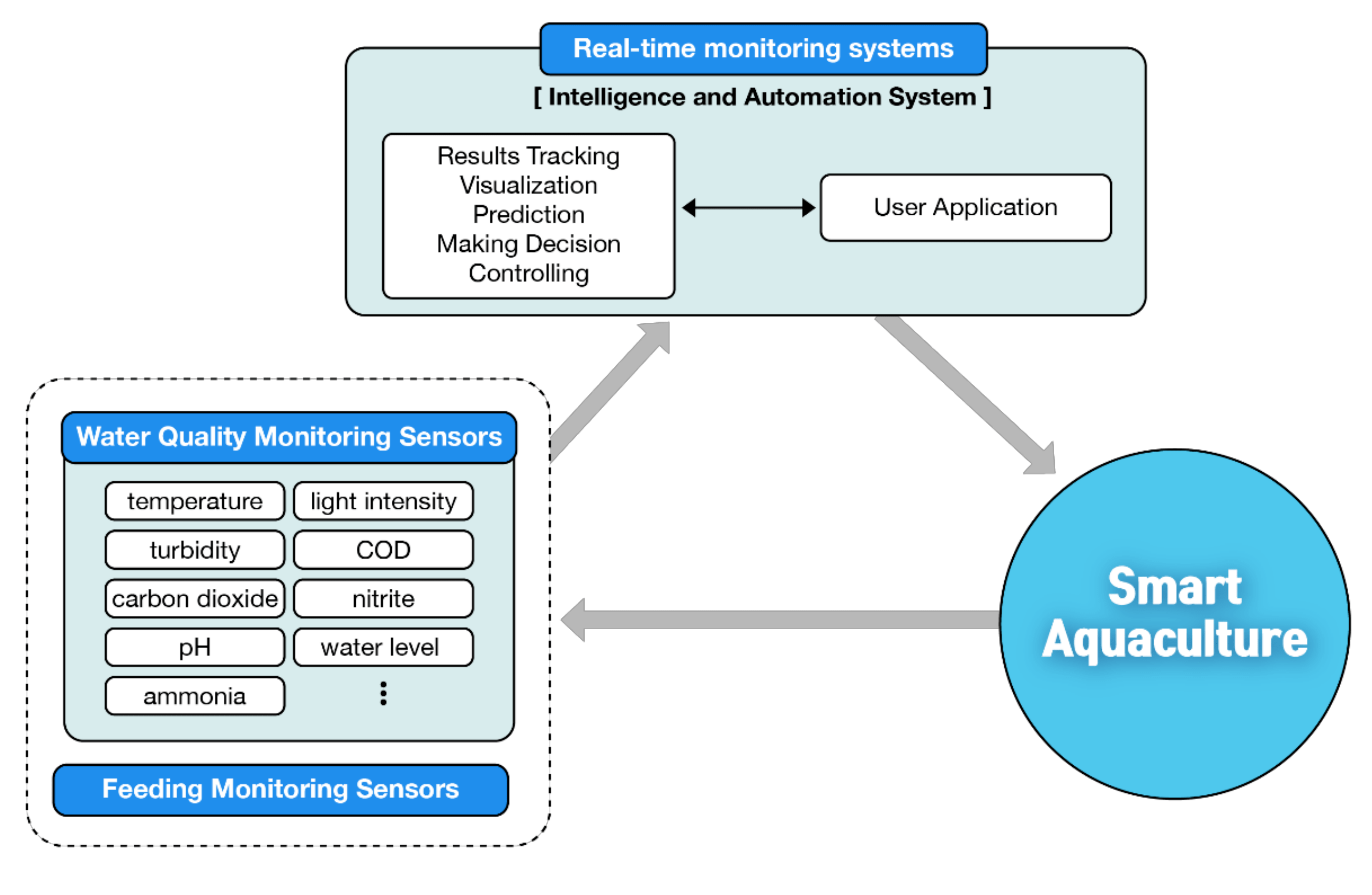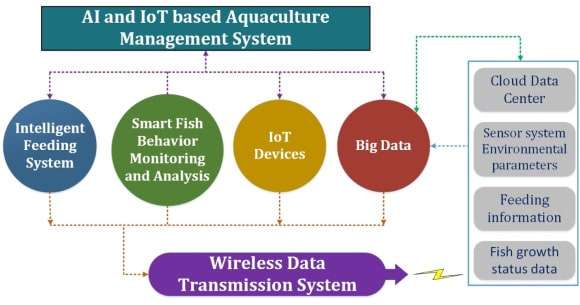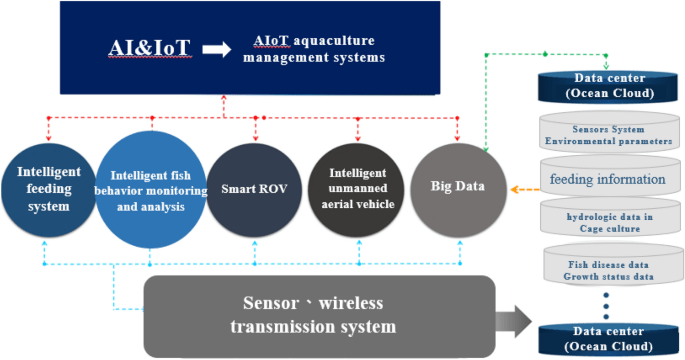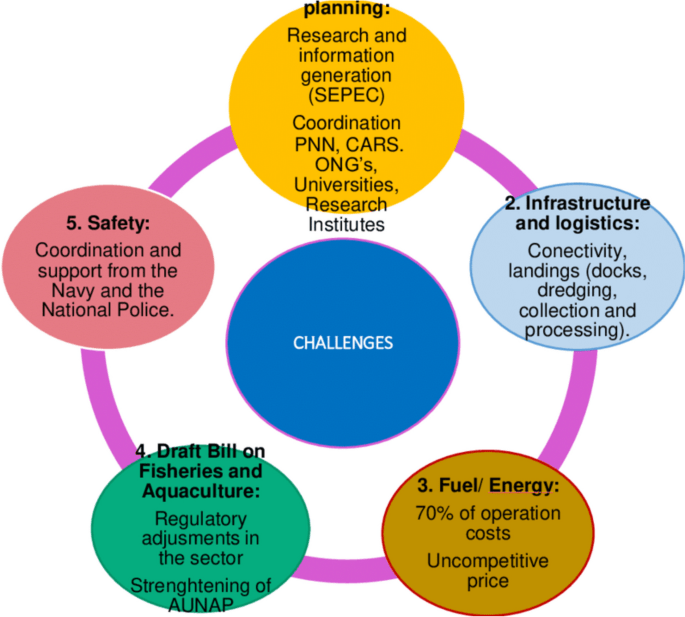Advancements in AI and Aquaculture
 Source
Source
- Automated Feeding Systems: AI-driven cameras and sensors monitor fish behavior, adjusting feeding schedules and quantities for optimal growth and minimizing waste.
- Water Quality Management: AI algorithms analyze real-time data from sensors to maintain the ideal water conditions, preventing disease outbreaks and improving fish health.
- Disease Detection and Prevention: Machine learning models identify early signs of diseases by analyzing fish behavior and symptoms, enabling timely intervention.
- Genetic Enhancement: AI assists in breeding programs by analyzing genetic data, helping develop disease-resistant and more robust fish breeds.
- Autonomous Underwater Vehicles (AUVs): AI-powered AUVs monitor ocean conditions, track fish populations, and survey underwater environments.
- Predictive Analytics: AI algorithms process historical data to predict market demand, optimizing production planning and reducing financial risks.
Benefits of AI in Aquaculture
 Source
Source
1. Increased Efficiency
Automation reduces labor-intensive tasks, improving overall efficiency in operations.2. Sustainability
AI-driven precision in feeding and resource management minimizes environmental impact.3. Yield Optimization
Accurate data analysis leads to better decision-making, resulting in higher yields and profitability.4. Disease Management
Early detection and preventive measures reduce disease-related losses, enhancing farm sustainability.5. Innovative Breeding
AI accelerates selective breeding, producing healthier and more resilient fish populations.Artificial Intelligence’s Potential to Improve Aquaculture Productivity
Farming fish, which is called aquaculture, is getting a boost from smart computers called Artificial Intelligence (AI). This special technology is not just for fish; it’s spreading to many businesses. In fish farming, we need smart and lasting ideas because it’s growing really fast. AI is like a superhero for fish farming because it helps us do the job better. It makes things faster, saves money, and helps make sure fish farming can keep going for a long time. Artificial intelligence plays a wide variety of roles in aquaculture, from health monitoring to improving feeding regimens. These tasks were historically quite labor-intensive and prone to human mistakes. But with AI, we can automate these tasks, cutting down on labor expenses while also boosting precision. Artificial intelligence is used mostly in aquaculture for fish health monitoring. Artificial intelligence-driven systems can examine footage captured by underwater cameras for indications of illness or stress in fish. Through prompt intervention made possible by this early diagnosis, fish mortality rates can be lowered and yields increased. Fish thrive on water with the right temperature, pH, and oxygen levels, all of which may be tracked by such devices. Artificial intelligence is also changing the way fish are fed in aquaculture. Underfeeding can prevent fish from reaching their full potential while overfeeding can reduce the water’s purity and waste feed. Data on fish size, activity levels, and environmental factors can be analyzed by AI to decide the best time to feed the fish. This method of feeding precisely increases fish productivity while decreasing waste and negative effects on the environment. Artificial intelligence (AI) can also help predict and reduce hazards in aquaculture. Artificial intelligence programs, for instance, can examine past and present data to foresee disease outbreaks or unfavorable weather circumstances. Because of this foresight, farmers may take precautions to lessen any possible losses.AI Help in Breeding Operations

Challenges to Address
- Data Security: Protecting sensitive farm data from cyber threats is paramount.
- High Initial Cost: Implementing AI systems can be expensive, especially for small-scale farmers.
- Skill Gap: Training personnel to operate and maintain AI systems requires specialized knowledge.
- Ethical Concerns: Balancing AI usage with ethical considerations surrounding animal welfare and genetic modification.
 Source
Source
The Future Outlook
The trajectory of AI in aquaculture is undeniably promising. As technology becomes more accessible and refined, its integration into aquaculture operations will likely increase. AI’s role in ensuring sustainable seafood production, reducing waste, and enhancing profitability will become even more crucial. In the coming years, we can expect:1. Diversification of Species
AI will aid in the farming of a broader range of species, expanding seafood choices.2. Smarter Feed Formulations
AI will fine-tune feed compositions for optimal nutrition and growth.3. Real-time Market Insights
AI will provide up-to-the-minute market data, enabling farmers to make informed decisions.FAQs
No, AI serves as a tool to enhance efficiency and decision-making, but human expertise remains crucial.
AI optimizes resource usage, reduces waste, and helps prevent disease outbreaks, minimizing environmental impact.
The initial costs can be high, but as technology advances, prices are likely to decrease over time.
Yes, AI-powered underwater vehicles can monitor fish populations, aiding in sustainable fishing practices.
Implementing AI requires real-time data on water conditions, fish behavior, and growth patterns for accurate analysis.
AI’s influence on traditional fisheries can vary; it can enhance stock management but may also require reskilling in affected communities.
Absolutely, AI aids in optimizing feed usage, water quality, and waste management, minimizing environmental impact.
To End Our Review on Role of AI in Aquaculture
The year 2023 has been a pivotal one for the intersection of AI and aquaculture. The fusion of cutting-edge technology with a traditional industry is propelling aquaculture into a new era of efficiency, sustainability, and innovation.
While challenges remain, the benefits of AI integration are clear, offering a glimpse of a future where seafood production meets the demands of a growing global population while safeguarding our oceans and resources. The rise of AI in aquaculture is a journey marked by collaboration between human ingenuity and technological prowess, and it holds the potential to revolutionize how we farm and consume seafood.

